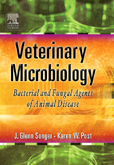|
|
|
| |
 |
|
|

|
 推薦指數:
推薦指數:





|
|
- 內容介紹
|
Veterinary Microbiology - Bacterial and Fungal Agents of Animal Disease
By J. Glenn Songer, PhD; and Karen W. Post, DVM, MS
Approx. 448 pages, Approx. 300 illustrations, Copyright 2005
ISBN:0721687172
Description
Containing the latest information on pathogenesis and diagnosis, Veterinary Microbiology addresses both specific, defined problems, as well as trends in host/parasite interaction. This book is a complete reference on microbial biology, diseases, diagnosis, prevention, and control. It also provides a foundation of knowledge on pathogens and how they interact with hosts.
Key Features
Contains a comprehensive, up-to-date overview of bacterial and fungal agents that cause animal disease, including recently identified organisms as well as the pathogenesis of emerging diseases.
Features more than 100 full-color illustrations to visually reinforce key concepts.
The book is logically organized for ease of use and quick reference in the clinical setting.
Addresses diseases that can affect animal productivity, both for individual animals as well as herd health.
Discusses the implications of various organisms in biological warfare and bioterrorism.
Table of Contents
SECTION 1: INTRODUCTION 1. Evolution of virulence 2. General principles of diagnosis 3. Antimicrobial susceptibility testing and principles of antimicrobial therapy SECTION 2: VETERINARY BACTERIOLOGY Gram positive aerobic cocci 4. Staphylococcus 5. Streptococcus and Enterococcus Gram positive aerobic rods 6. Actinomyces and Arcanobacterium 7. Bacillus 8. Corynebacterium 9. Dermatophilus and Nocardia 10. Listeria and Erysipelothrix 11. Mycobacterium 12. Rhodococcus Gram negative bacteria Enterobacteriaceae 13. Escherichia and Shigella 14. Klebsiella 15. Proteus 16. Salmonella 17. Yersinia 18. Bordetella 19. Burkholderia and Pseudomonas 20. Aeromonas and Vibrio 21. Moraxella and Neisseria 22. Actinobacillus 23. Mannheimia and Pasteurella 24. Haemophilus and Taylorella 25. Brucella 26. Francisella 27. Infrequently-encountered Gram-negative rods: Ornithobacterium rhinotracheale, Streptobacillus moniliformis, Legionella spp, Riemerella spp, Bartonella spp, and Chromobacterium spp Curved and spiral-shaped bacteria 28. Campylobacter, Helicobacter, and Arcobacter 29. Brachyspira and Serpulina 30. Lawsonia 31. Leptospira 32. Treponema and Borrelia Anaerobic bacteria Anaerobic Gram positive rods and cocci 33. Clostridium 34. Other Gram-positive anaerobes Anaerobic Gram negative rods 35. Bacteroides 36. Dichelobacter 37. Fusobacterium 38. Prevotella and Porphyromonas Bacteria without cell walls 39. Mycoplasma and Ureaplasma Obligate intracellular bacteria 40. Anaplasma, Eperythrozoon, and Hemobartonella 41. Chlamydia and Chlamydophila 42. Coxiella and Cowdria 43. Ehrlichia 44. Rickettsia and Neorickettsia SECTION 3: VETERINARY MYCOLOGY 45. Introduction to veterinary mycology 46. Cutaneous mycoses 47. Subcutaneous mycoses 48. Systemic mycoses 49. Opportunistic mycoses 50. Fungal-like agents
|
|
|

